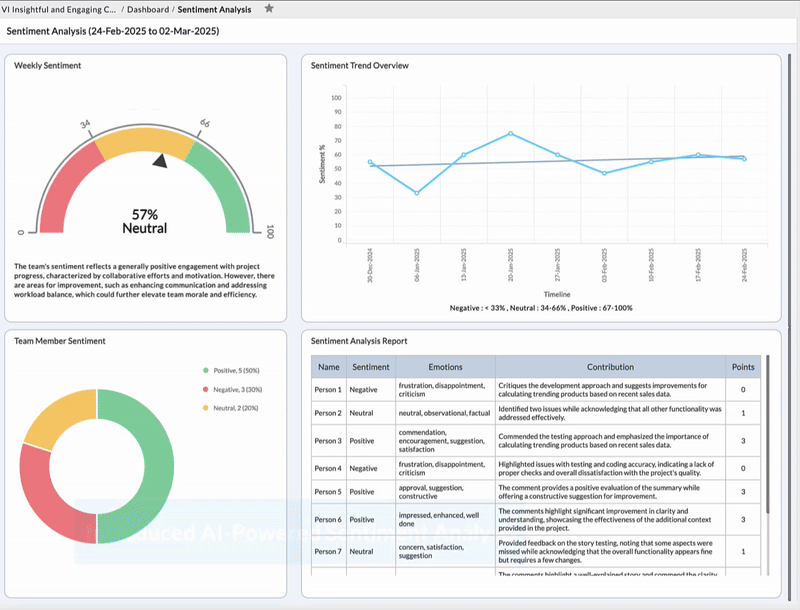|
Skip Ahead to: |
Overview
The Sentiment Analysis feature in Nimble provides powerful AI-driven insights into team morale by analyzing comments, kudos, and feedback from team members. By detecting whether sentiments are positive, neutral, or negative, helps leaders understand how team members feel towards their work, improve team morale, and foster a more humanized workplace where employees feel valued, heard, and engaged.
Note: Please contact the Nimble Support Team for details on its implementation and availability for your organization.
Why use Sentiment Analysis?
- Stay connected to team morale without waiting for formal feedback sessions.
- Identify challenges early, such as frustration or disengagement, to intervene timely.
- Celebrate positivity and foster an encouraging work environment.
- Make informed decisions backed by real-time team sentiment data.
Example for better understanding: A Product Manager can review team sentiment after a product release to gauge team satisfaction with the outcome and process.
Navigation
To access Sentiment Analysis for your project: Go to the Dashboard module of your project and select Sentiment Analysis from the list.
Note: Sentiment Analysis insights are generated automatically using AI based on team comments and interactions within the last week.
Key Features
- AI-Powered Sentiment Tracking: Automatically analyzes comments to detect and categorize sentiments.
- Insightful Visualization: Graphical widgets make it easy to grasp overall and detailed sentiment data.
- Trend Monitoring: Weekly trends help track shifts in morale over time and correlate them with project events.
- Privacy-Focused: Individual identities remain anonymous, ensuring a safe space for honest feedback.
- Actionable Insights: Highlights specific concerns, areas for improvement, and positive feedback to guide managers in taking meaningful actions.
Who Should Use Sentiment Analysis?
Access to Sentiment Analysis is recommended for managerial roles responsible for team well-being and productivity:
- Product Managers
- Project Managers
- Product Owners
- Resource Managers
- Scrum Masters
Tip: By regularly reviewing sentiment insights, leaders can create a more humanized workplace where employees feel valued, heard, and motivated.
Important Notes
- Privacy Assured: Individual team members’ names are anonymized (e.g., “Person 1”) to maintain confidentiality.
- Data Scope: Analysis is based on comments and interactions from the previous week, ensuring up-to-date sentiment tracking.
- AI Evaluation: Sentiments, emotions, and contributions are assessed automatically by AI, reducing manual effort and bias.
- Points System: AI assigns points based on sentiment—positive (3 points), neutral (1 point), and negative (0 points)—which can help track constructive participation over time.
Understanding the Sentiment Analysis Widgets
The Sentiment Analysis page comprises four key widgets that comprehensively view team sentiment. Let’s understand each of these widgets in detail.
1. Weekly Sentiment (Dial Chart)
- What it shows:
The overall percentage distribution of positive, neutral, and negative sentiments for the past week. - Why it’s useful:
A quick snapshot of team mood. If sentiment is largely neutral or negative, it may indicate issues needing attention. - AI-generated Summary:
A textual summary highlights the underlying team dynamics, such as motivation, concerns, or areas needing improvement.
2. Team Member Sentiment (Donut Chart)
- What it shows:
A categorical breakdown of how many team members expressed positive, neutral, or negative sentiments of the past week. - Why it’s useful:
Helps understand diversity in team feelings. A few negative sentiments in an otherwise positive environment may highlight specific concerns that need addressing. Example: If 50% are positive, 30% negative, and 20% neutral, it indicates mixed feelings, signaling a need for a follow-up conversation.
3. Sentiment Trend Overview (Line Chart)
- What it shows:
A weekly trend line showing how team sentiment has evolved over the past three months. - Why it’s useful:
Helps correlate sentiment shifts with project events (e.g., releases, deadlines) and see if interventions are improving morale over time. - Data Range:
Weekly sentiment scores averaged over 12 weeks, enabling managers to identify long-term patterns. Example: A dip in sentiment around a release date could indicate stress or dissatisfaction with the release process.
4. Sentiment Analysis Report (Table Report)
- What it shows:
The Sentiment Analysis Report is presented in a tabular format with five columns:
| Column | Description |
| Name | Displays an anonymized identity (e.g., Person 1, Person 2). Individual names are hidden for privacy, ensuring that feedback is candid and unbiased. |
| Sentiment | AI-detected overall sentiment of the comment—can be Positive, Neutral, or Negative, based on the tone and wording of the feedback. |
| Emotions | AI lists specific emotions and tones detected in the comment, such as frustration, encouragement, suggestion, satisfaction, criticism, concern, approval. |
| Contribution | AI summarizes the main point or idea shared by the team member, highlighting issues, suggestions, commendations, or constructive feedback. |
| Points | Numerical value assigned to the comment based on the sentiment: 3 points for Positive, 1 point for Neutral, and 0 points for Negative comments. Useful for analyzing overall contribution quality. |
- Why it’s useful:
Offers granular insight into specific praises or concerns that might otherwise go unnoticed, enabling targeted action.
Conclusion
The Sentiment Analysis feature in Nimble is a powerful lens into team morale, helping managers create a responsive, engaging, and motivated work environment. By proactively tracking sentiment, you can address concerns early, boost morale, and ensure that every team member feels heard and valued.co





